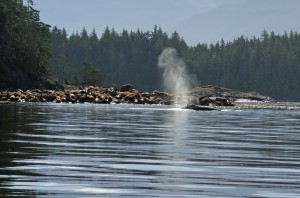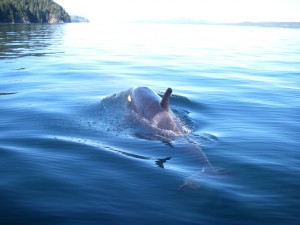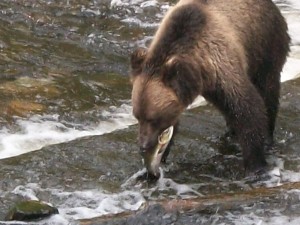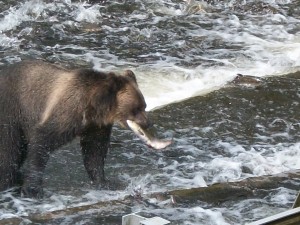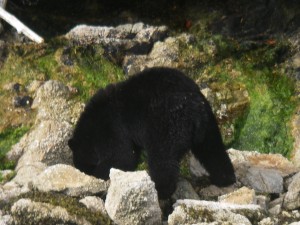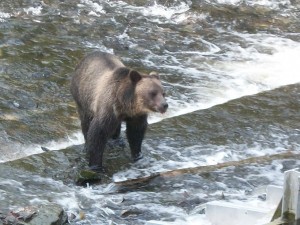Grizzly Bear and Wildlife Tour Blog
We offer an exceptional fly-in lodge for Grizzly Bear Watching and Whale Watching in British Columbia.
Learn about What’s happening at the Lodge, view our British Columbia’s Wildlife Report, read our Grizzly Bear Watching Blog and Whale Watching Blog. Learn more about a Day on the River Blog, see Our Tour Guide’s Photos & Blog and Photos from Our Guests.
Male humpie
Male pink salmon develop a large hump on their back during spawning, hence the nickname humpback (humpie) salmon. They are the smallest of the fall spawning Pacific salmon. Pinks have a very regular life history, living for two years before returning to spawn the next generation. Pink fry do not rear in freshwater. Immediately after emerging they move downstream to the estuary and rear there for several months before heading out to the open ocean. Because of this, pink fry have no spots, which provide camouflage in streams, but are bright chrome for open water.
The only interest the grizzly has in the life cycle of the pink salmon is their sex. At certain times in their feed grizzly will drop a male humpie to catch a female which contain the high fat content roe (eggs). During this peak of the run when grizzlies have access to an abundance of salmon at that time they will eat only the parts highest in calories – the eggs, skin and brains.
Lunch visitors – sealions
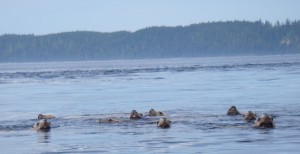
A raft of sealions in the water on land they would be a colony. Steller sealions are the largest of all sea lions and they have an appetite to match. These giant pinnipeds are carnivores and hunt fish, squid, octopus and rarely smaller seals. They are found off northern Pacific coasts from Alaska to California. In the past few years more of these sea lions are remaining in our viewing area all summer rather than continuing their trek from California to Alaska in the spring and then rejoin their south bound relatives in the fall. The area adjacent to Stubbs Island near Telegraph Cove BC is a popular haul out area for this small summer colony numbering up to three dozen mammals. On a calm day we will tie to the kelp and have lunch and often visitors.
Third – TWO for one – grizzly bear and salmon
This could actually be a three for one photo. The unfortunate salmon in the grizzly bears mouth that will not live to spawn, the salmon coming over the small falls to the right and the third salmon behind the bears shoulder that is just clearing the water and coming up stream. The viewing stands on Knight Inlet’s Glendale River are used after August 24th and provide great opportunities for interesting photos even if the interesting part is a result of chance. The guests always say one can never have too many photos to take home while the guides are trying to encourage them to put down the cameras for a few minutes and enjoy all the sights not just those seen through the camera lens. The stands are located so that the action is 360 degrees not just the small arc of the camera.
My morning perspective
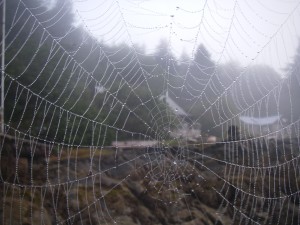
Some mornings I may have too much time on my hands. We rise at 6:30 start coffee, finish setting the breakfast table and load our boats with the picnic lunches and check for fuel. The guests are called at 7:00 and we depart before 8:00 for the day’s activities. Sometime in there I noticed the spider web on the scales used to weight the salmon, in the background the lodge. I think artist license rather than boredom.
Black Bear pose
Fortunately this is not a permanent pose only a common position we often find bears using on our tours. At low tide bears come to the beach for food and that requires them to turn over rocks to get at the high protein crab, clams, barnacles, amphipods and other tiny invertebrates. Rocks roll easier down hill so we often have a great view of their backside. This black bear like others will eventually move to another rock and prove more photogenic. The good aspect of this photo is that it shows we are not interrupting their feeding or disturbing their natural habits as the motto we tend to use as guides is “ Leave them as we find them.” Part is we want to be able to come back to the same area another day and not to have the bears run when we approach but the main reason is that it is good stewardship.
Grizzly bear with too many choices
This grizzly could be getting full or just confused. Checking it’s mouth there is the pink tinge of salmon blood of one less salmon that will make it to the spawning grounds so this bear may be getting full. The confusion comes from the water in front of the log and all the pink salmon fins that are breaking the surface. This bear has chosen one of the entrance shuts to the spawning channel (the two white metal arms in the bottom right corner of the picture) to be its fishing site. This is often referred to as the Glendale River buffet. Janis Worsley of the UK captured a pause in the action, maybe even a catnap.
Second – TWO for one – orca coming

I was fortunate to be in the right place at the right time several years ago. The closeness to the boat is revealed in the fact that my camera is a “Pentax Optio with a 3X Optical Zoom” and I was not using much of the zoom. The “TWO for” aspect of the photo is the second orca under water to the left. Orcas are member of the dolphin family and as such are curious. On many occasions over the years I have seen orca change their direction of travel to come close to a boat and even make circles around the boat to check out the occupants. The “checking out” is obvious as they turn on their side to get a better view and on one occasion a spyhop about seven meter (20 feet) behind the boat. Sometime sitting and waiting is the best option.
Bald eagle feeding
“Once an eagle spots a fish swimming or floating near the water surface, it approaches its prey in a shallow glide and then snatches the fish out of the water with a quick swipe of its talons. Eagles can open and close their talons at will; although, a hungry eagle can be dragged into the water when refusing to release a heavy fish. Unfortunately, the eagle might drown during the encounter with the fish; eagles are strong swimmers, but if the water is very cold, it may be overcome by hypothermia. If an eagle falls into the water during an aerial fight over food with another eagle or accidentally falls into the water, they are able to take flight from the water surface. Because of the energy expended during hunting, an eagle has to spend a lot of time resting quietly. It’s estimated that only one out of eighteen attempts at attacking its prey is successful. Note: a bald eagle’s lifting power is about 4 pounds.” American Bald Eagle Information at baldeagleinfo.comThis photo was provided by Glen one of the lodge’s guides and was taken near the lodge on Minstrel Island BC.
First – TWO for one – humpback and sealions
